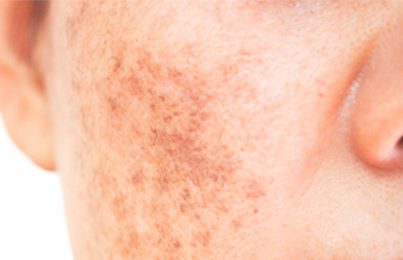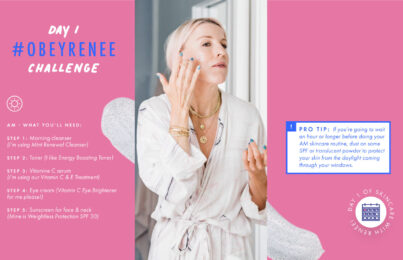Updated 7/1/25. By now, we all know that sun exposure can spell trouble for our skin. What people often overlook, though, is the fact that the heat generated by that giant ball of radiation in the sky can have detrimental effects of its own.
In a lot of ways, I actually think summer is harder on our skin than any other season. Winter gets a bad rap (and certainly comes with its own set of challenges), but I see summer causing such a wide range of skin problems for people. And heat is the root cause of many of them.
Keep reading for five ways the summer heat could be causing problems for your skin (and of course, my expert solutions!).
1. Dehydration
Most people associate dehydrated skin with cold winter air and heaters running 24/7. In reality, hot summer temperatures are just as likely to be zapping moisture from your skin! Heat increases water loss, so unless you live in a very humid environment, this could cause your skin to feel tight. To top it all off, the constant onslaught of AC acts as an additional source of dehydration.
Along with tight-feeling skin, another sign of dehydration is visible fine lines. Dehydration exacerbates these and makes them appear more prominent.
If you’re out in the heat during the day, there isn’t always a whole lot you can do to prevent this moisture loss. I certainly recommend using a hydrating vitamin C serum in the morning followed by a moisturizer with sunscreen, but the real work will be done during your evening routine. This is when you want to replenish your skin with what are called “indirect antioxidants”, which will also help with cellular repair while you sleep. Firm + Repair Overnight Serum works incredibly well for this and one I recommend all the time to my clients.
2. Increased Sensitivity
When our skin becomes dehydrated, it can lead to a damaged moisture barrier. When the moisture barrier—which protects our skin from external aggressors—becomes disrupted, we start to experience more skin sensitivity. For example, skincare products you can normally use may suddenly start to sting. The reason for this is when you have a damaged moisture barrier, tiny, invisible cracks develop in the skin. These cracks allow things to get into the skin in a way they normally wouldn’t and expose your nerve endings, hence the stinging. You may also experience redness, itching, or rough-feeling skin.
If you’re dealing with summer skin sensitivity, the first step is to add moisture back into the skin in the ways outlined above. Second, keep it simple. Cut back on overly active ingredients and extra steps in your routine, and just stick to the basics—those being a cleanser, moisturizer, and sunscreen. If you want to add in some intensive barrier repair, sleeping in Rest Day Masque is magic! Not only is it deeply hydrating, but it’s also calming and soothing, which can correct redness and sensitivity.
Read how to tell if your moisture barrier is damaged (and what to do about it!).
3. More Visible Capillaries
Speaking of redness, summer is no friend to those of us prone to broken capillaries! When people talk about “broken capillaries,” what they’re really referring to are dilated capillaries. Heat causes our capillaries to expand and when they do, they accommodate more blood flow. This is what gives some of us red or flushed skin when it’s hot out. After expanding, our capillaries are designed to shrink back to their regular size. Repeat this process enough times, though, and they lose their ability to bounce back. Once capillaries become permanently enlarged, they stay visible under the surface of the skin.
So, what can be done about this? Obviously, when it’s hot outside, there’s only so much we can do to avoid it. If you’re prone to broken capillaries, my best advice is to avoid additional heat as much as possible. This means no scalding-hot showers, steam rooms, hot yoga, etc. It may also be beneficial to take a vitamin C supplement with bioflavonoids since this can help strengthen blood vessels.
Read 7 ways to prevent broken capillaries.
4. Worsened Hyperpigmentation
I’ve spoken about this a lot, but that’s because it’s so often overlooked. Heat is just as big a culprit as sun exposure when it comes to hyperpigmentation. This means you could spend all day in the shade, wearing a hat and slathered in sunscreen, but if it’s hot out and your internal temperature is rising, pigment cells will still be triggered.
But fighting hyperpigmentation is an uphill battle, and it’s normal to see a little more of it as we get older since pigment cells start to rise to the surface over time. If there are enough of them, they can bunch together. When this happens, we start to see brown spots and an uneven skin tone.
Luckily, there are a few ways you can fight back against hyperpigmentation. First, it goes without saying that you should avoid direct sun exposure and overheating the skin as much as you can. Secondly, using the ingredient tranexamic acid (it’s NOT an exfoliating acid) is gentle to use all summer long and you can find it in HyperFix Fading Toner. In addition, use a no-sting, no-burn vitamin C serum and broad-spectrum sunscreen (reapplied often when outdoors) every single day. Consistency is key here!
For a deep dive into how to fade it, I highly recommend you watch my full hyperpigmentation video.
5. Increased Oil Production
Regardless of your skin type, heat can increase your skin’s oil production. For some, this translates to an increase in clogged pores and breakouts. This is especially true if you’re also dealing with the summer dehydration I mentioned (yes, your skin can be both oily AND dehydrated!). In this case, excess oil gets trapped under dry, expired cells, which increases the likelihood you’ll develop clogged pores and blemishes. (This is just one of the common causes of summer breakouts.)
In addition, increased oil flow can expand the walls of your pores. The stretches your pores and can make them appear larger. Regulating oil flow is just one of the ways to minimize the appearance of large pores.
One method I recommend for controlling oily summer skin is switching to a moisturize that help can reduce oil like Daily Mattifying Solution.
I also suggest switching to a low-foaming cleanser in the morning. I love something like AHA/BHA Blemish Control Cleanser. It removes excess oil without being harsh and includes both beta- and alpha-hydroxy acids to cut through sebum. Pro Tip: leave the cleanser on your skin for a minute or two before washing it off. This gives the active ingredients some time to get to work and have more of an effect!
There you have it, five of the most common skin problems I see in hot weather and how to fix them! I hope these tips help you keep your skin on track so all you have to worry about this summer is finding fun ways to escape the heat. As you can see from the pic above taken at Lady Bird Lake in Austin, I love getting near water to cool off as much as I can!
Oh, one last tip for you. Think you should stop using retinol during the summer? Absolutely not. You don’t want to pull the plug on retinol because you’ll stop the results. Just use a gentler one like Advanced Resurfacing Serum.
Celebrity Esthetician & Skincare Expert
As an esthetician trained in cosmetic chemistry, Renée Rouleau has spent 35 years researching skin, educating her audience, and building an award-winning line of products. Her hands-on experience as an esthetician and trusted skin care expert has created a real-world solution — products that are formulated for nine different types of skin so your face will get exactly what it needs to look and feel its best. Trusted by celebrities, editors, bloggers, and skincare obsessives around the globe, her vast real-world knowledge and constant research are why Marie Claire calls her “the most passionate skin practitioner we know.”



